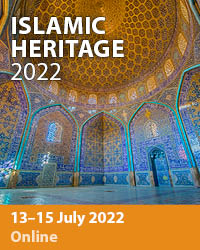4th International Conference on Islamic Heritage Architecture and Art
13–15 July 2022
Lisbon, Portugal
Introduction
The meeting will deal with the design of many types of buildings in Islamic countries, including not only the better known public buildings like mosques, mausolea, citadels and forts, but also houses and gardens, engineering works such as bridges and dams, irrigation systems and many others which have also had a profound impact on society.
Islamic architecture has enriched design with a wide variety of structural shapes, including among others, unique arches, a wide variety of vaults and domes which allow for new forms to be developed. The influence that these structural forms have in non-Islamic countries will be one of the themes of the conference.
There is much to learn from past experiences to arrive at solutions that are environmentally sound and sustainable in the long term. As conventional energy resources become scarce, the Islamic design heritage can offer invaluable lessons on how to deal in an efficient manner with cases of hard and extreme environments. Traditional architecture and urban environments in most Islamic countries are now being eroded by overemphasis on a global type of architecture and city planning. As a consequence, many regions are losing their identity. The conference will aim to review these developments in the light of what the classical Islamic urban designs and architectures have to offer modern society.
An equally important part of the meeting will analyse the materials employed and the types of structural elements, particularly those unique to Islamic architecture. Associated topics of discussion will include music, textiles and ceramics, which are essential parts of the architectural fabric. The Conference will encompass papers on construction materials, including not only stone and brick but also more perishable materials like adobe, wood and reeds.
Preserving that heritage also requires the development of appropriate conservation techniques in response to the different materials used and the ways structural forms work, including under extreme conditions, such as earthquakes.
Papers relevant to the influence of Islamic architecture on the development of new structural form, shape and design in Western countries are particularly welcome.
The meeting will be of interest to all researchers, practitioners and government employees actively involved in the topic of Islamic heritage architecture and art.
All published papers from previous meetings are archived in the Wessex Institute eLibrary (www.witpress.com/elibrary) where they are easily and permanently available in Open Access format to the international community.
Conference Topics
The following list covers some of the topics to be presented at Islamic Heritage 2022. Papers on other subjects related to the objectives of the conference are also welcome.
- Historical aspects
- Heritage studies
- Archaeological studies
- Mosques and minarets
- Conservation and restoration
- Citadels and fortifications
- Urban environment
- Baths and Caravanserais
- Palaces
- Houses and gardens
- Bridges and dams
- Irrigation systems
- Climate adaptability
- Structural characteristics
- The use of light and orientation
- Construction materials
- Oman and Eastern Saudi Arabian architecture
- Architecture in Malaysia and Indonesia
- Mediterranean Islamic heritage
- The upper Gulf (Kuwait and Basra)
- The central Gulf (Bahrain and Qatar)
- The lower Gulf architecture
- The Persian coast and islands
- The Trucial coast (Abu Dhabi, Dubai and the Northern Emirates)
- Classical Ottoman architecture
- The Balkans legacy
- The Black and Caspian sea legacies
- Islamic architecture along the Silk Road
- Islamic architecture in China
- Afghanistan and Persia
- Islamic architecture in the ex-Soviet republics
- The Indian continent
- Islamic architecture in Al-Andalus and other Spanish regions
- Influences in the Americas
- Islamic architecture in Africa
- New cities and the search for authenticity
- Islamic architecture in Far East countries
- Cross-cultural encounters
- Travel writings
- Art and literature
- Islamic calligraphy and Islamic manuscripts
- Contemporary forms of Islamic arts
- Case studies
